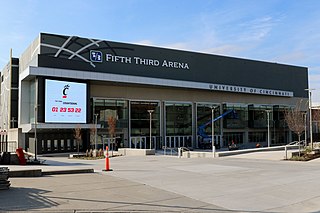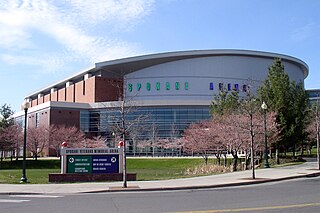
Spectrum Center is an indoor arena located in Uptown Charlotte, North Carolina. It is owned by the city of Charlotte and operated by its main tenant, the NBA's Charlotte Hornets. The arena seats 19,077 for NBA games but can be expanded to 20,200 for college basketball games.

PNC Arena is an indoor arena located in Raleigh, North Carolina. The arena seats 18,700 for ice hockey and 19,500 for basketball, including 61 suites, 13 luxury boxes and 2,000 club seats. The building has three concourses and a 300-seat restaurant.

Hank McCamish Pavilion, nicknamed The Thrillerdome and originally known as Alexander Memorial Coliseum, is an indoor arena located on the campus of the Georgia Institute of Technology in Atlanta, Georgia. It is the home of the Georgia Tech Yellow Jackets men's basketball and Yellow Jackets women's basketball teams.

The Veterans Memorial Coliseum is an indoor arena located in the oldest part of the Rose Quarter area in Portland, Oregon. The arena is the home of the Portland Winterhawks, a major junior ice hockey team, and was the original home of the Portland Trail Blazers of the National Basketball Association. It has been included on the National Register of Historic Places in recognition of its architectural significance.

Omni Coliseum was an indoor arena in Atlanta, Georgia, United States. Completed in 1972, the arena seated 16,378 for basketball and 15,278 for hockey. It was part of the Omni Complex, now known as the CNN Center.

The XL Center is a multi-purpose arena and convention center located in downtown Hartford, Connecticut. Owned by the City of Hartford, it is managed by the quasi-public Capital Region Development Authority (CRDA) under a lease with the city and operated by Spectra. In December 2007, the center was renamed when the arena's naming rights were sold to XL Group insurance company in a six-year agreement. The arena is ranked the 28th largest among college basketball arenas. It opened in 1975 as the Hartford Civic Center and was originally located adjacent to Civic Center Mall, which was demolished in 2004. It consists of two facilities: the Veterans Memorial Coliseum and the Exhibition Center.

Welsh–Ryan Arena is a 7,039-seat multi-purpose arena in Evanston, Illinois, United States, near the campus of Northwestern University. It is home to four Northwestern Wildcats athletic teams: men's basketball, women's basketball, women's volleyball, and wrestling. It is located inside McGaw Memorial Hall, to the north of Ryan Field.

Thompson–Boling Arena at Food City Center is a multi-purpose arena on the campus of the University of Tennessee in Knoxville, Tennessee. The arena opened in 1987. It is home to the Tennessee Volunteers (men) and Lady Vols (women) basketball teams. Since 2008, it has been home to the Lady Vols volleyball team. It is named after B. Ray Thompson and former university president Edward J. Boling. The basketball court is named "The Summitt" after the late Lady Vols basketball coach Pat Summitt. It replaced the Stokely Athletic Center. The mammoth octagonal building lies just northwest of the Tennessee River, and just southwest of Neyland Stadium. As an echo of its neighbor and a tribute to the brick-and-mortar pattern atop Ayres Hall, the baselines of the court are painted in the familiar orange-and-white checkerboard pattern.

Fifth Third Arena is an indoor arena in Cincinnati, Ohio, United States. The arena opened in 1989 and is located on the campus of the University of Cincinnati. It primarily serves as the home venue for the Cincinnati Bearcats men's basketball, women's basketball, and women's volleyball teams and hosts other events. It is located in the Myrl H. Shoemaker Center, which was also the name of the arena until 2005, when it was named for Cincinnati-based Fifth Third Bank.

The North Charleston Coliseum is a multi-purpose arena in North Charleston, South Carolina. It is part of the North Charleston Convention Center Complex, which also includes a performing arts center and convention center. It is owned by the City of North Charleston and managed by ASM Global. The coliseum opened in 1993, with the performing arts center and convention center opened in 1999. The complex is located on the access road to the Charleston International Airport.

The CHI Health Center Omaha is an arena and convention center in the central United States, located in the North Downtown neighborhood of Omaha, Nebraska. Operated by the Metropolitan Entertainment & Convention Authority (MECA), the 1.1-million-square-foot (100,000 m2) facility has an 18,975-seat arena, a 194,000 sq ft (18,000 m2) exhibition hall, and 62,000 sq ft (5,800 m2) of meeting space.

Allen County War Memorial Coliseum is a 13,000-seat multi-purpose arena located in Fort Wayne, Indiana, near present-day Johnny Appleseed Park. It opened in 1952 with a construction cost of nearly $3 million. The Allen County War Memorial Coliseum was originally designed to seat 8,103 for hockey or 10,240 for basketball. Opened in 1989, the Coliseum's $26 million Exposition Center contains 108,000-ft² (0.100-km2) devoted to hosting substantial trade shows and other events with seating for 7,500.
Charles Koch Arena is a 10,506-seat multi-purpose arena in Wichita, Kansas, United States. It is located on the southeast corner of 21st and Hillside on the campus of Wichita State University in northeast Wichita. The arena is home of the Wichita State Shockers men's basketball, women's basketball, and women's volleyball teams.

The Stephen C. O'Connell Center, also known as the O'Dome, is a 10,500-seat multi-purpose arena located on the University of Florida campus in Gainesville, Florida. The facility is named for the sixth president of the university, Stephen C. O'Connell, who served from 1967 to 1973. The facility is located on the northern side of the university's campus, between its football field, Ben Hill Griffin Stadium at Florida Field, and the James W. "Bill" Heavener Complex athletic training center.

The WVU Coliseum is a 14,000-seat multi-purpose arena located on the Evansdale campus of West Virginia University in Morgantown, West Virginia. The circular arena features a poured concrete roof. It was built with state funds and replaced the WVU Fieldhouse, which seated 6,000.

Spokane Veterans Memorial Arena is a multi-purpose arena in the northwestern United States, located in downtown Spokane, Washington. Opened in 1995, it is home to the Spokane Chiefs of the Western Hockey League (WHL).

The Paul J. Meyer Arena, which is part of the Ferrell Center, is an arena in Waco, Texas. Built in 1988 and located adjacent to the Brazos River, it is home to the Baylor University Bears volleyball and acrobatics and tumbling teams. It is named for Charles R. Ferrell, a Baylor student and legacy who died in 1967, and whose family's estate was a major benefactor of the arena. The building replaced the Heart O' Texas Coliseum as the school's primary indoor athletic facility. The men's and women's basketball teams relocated to the newly-constucted Foster Pavilion in 2024.

Bud Walton Arena is the home to the men's and women's basketball teams of the University of Arkansas, known as the Razorbacks. It is located on the campus of the University of Arkansas in Fayetteville, Arkansas and has a seating capacity of 19,368, which is the fifth largest for an on-campus arena in the United States.

Moody Coliseum is a 7,000-seat multi-purpose arena in University Park, Texas. The arena opened in 1956. It is home to the Southern Methodist University Mustangs basketball teams and volleyball team. It was also home to the Dallas Chaparrals and Texas Chaparrals of the American Basketball Association before they moved to San Antonio, Texas, as the San Antonio Spurs. It was also later the home for the Dallas Diamonds of the Women's Professional Basketball League.

Ed & Rae Schollmaier Arena, formerly known as Daniel–Meyer Coliseum, is a basketball arena located on the campus of Texas Christian University (TCU) in Fort Worth, Texas, United States. The arena is part of the Daniel-Meyer Athletics Complex and sits between Amon G. Carter Stadium and Sam Baugh Indoor Practice Facility. The arena is home to the TCU Horned Frogs Men's and Women's basketball teams. It was built in 1961 and originally named after former TCU football and basketball coach Dutch Meyer and former TCU board member Milton Daniel. As part of the 2015 renovation, the facility was renamed for lead donors Ed & Rae Schollmaier. The facility currently seats 6,800 people.

























